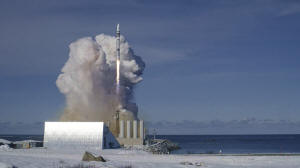|
The
28-meter-long (92-foot-long) Spectrum is a two-stage launch
vehicle specifically designed to put small and medium satellites
into orbit. The rocket lifted off from the pad at 12:30 p.m.
(1030 GMT) Sunday and flew for about a half-minute before the
flight was terminated, Isar said.
“This allowed the company to gather a substantial amount of
flight data and experience to apply on future missions,” Isar
said in a statement. “After the flight was terminated at T+30
seconds, the launch vehicle fell into the sea in a controlled
manner.”
Video from the launch shows the rocket taking off from the pad,
flying into the air and then coming back down to crash into the
sea in a fiery explosion.
The launch was subject to various factors, including weather and
safety, and Sunday's liftoff followed a week of poor conditions,
including a scrubbed launch on March 24 because of unfavorable
winds, and on Saturday for weather restrictions.
“Our first test flight met all our expectations, achieving a
great success,” Daniel Metzler, Isar’s chief executive and
co-founder, said in the statement. “We had a clean liftoff, 30
seconds of flight and even got to validate our Flight
Termination System.”
The company had largely ruled out the possibility of the rocket
reaching orbit on its first complete flight, saying that it
would consider a 30-second flight a success. Isar Aerospace aims
to collect as much data and experience as possible on the first
integrated test of all the systems on its in-house-developed
launch vehicle.
Isar Aerospace is separate from the European Space Agency, or
ESA, which is funded by its 23 member states.
“Success to get off the pad, and lots of data already obtained.
I am sure @isaraerospace will learn a lot," ESA Director General
Josef Aschbacher posted on X. "Rocket launch is hard. Never give
up, move forward with even more energy!”
ESA has been launching rockets and satellites into orbit for
years, but mainly from French Guiana — an overseas department of
France in South America — and from Cape Canaveral in Florida.
All contents © copyright 2025 Associated Press. All rights reserved

|
|




